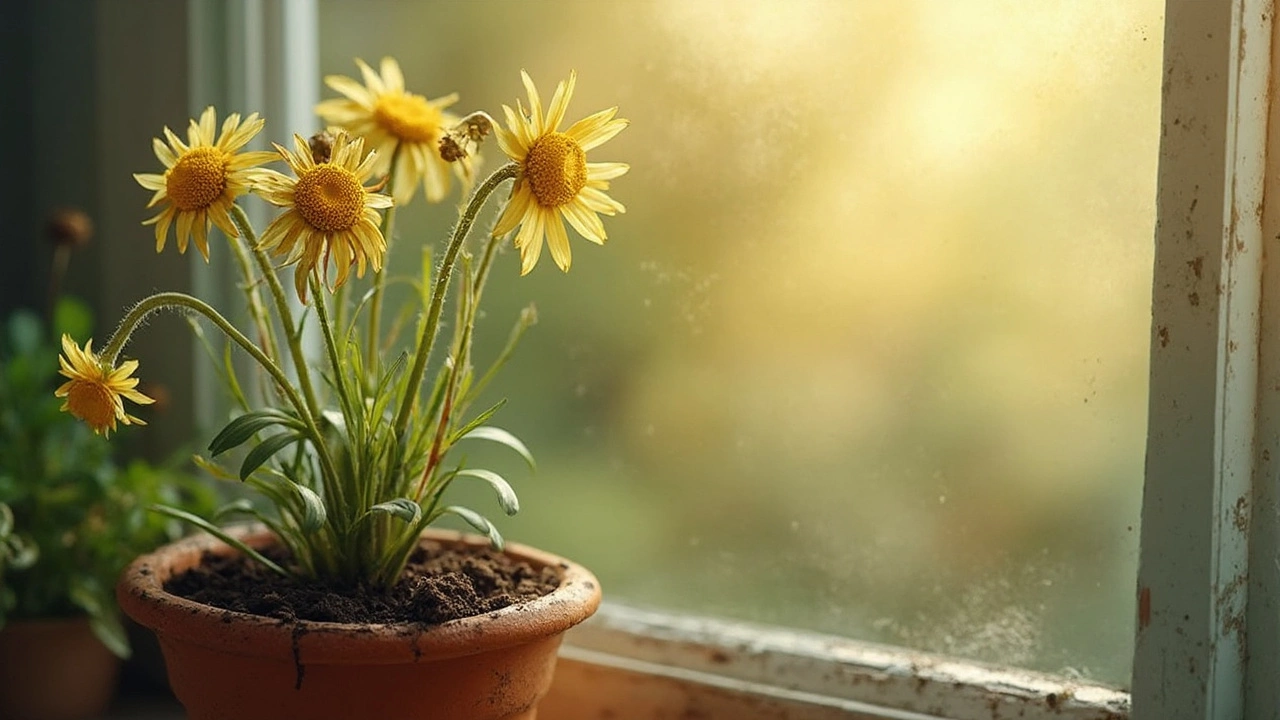We've all been there - eagerly tending to our beloved daisies, only to love them a little too much. Overwatering is like smothering your plants with too much attention, and it can be a common pitfall for indoor garden enthusiasts. But no worries, let's nip this problem in the bud.
First things first, spotting an overwatered daisy involves a little detective work. Picture this: yellow leaves, droopy petals, and, sometimes, a not-so-pleasant aroma from the soil. These are all red flags that your daisy is feeling a bit too soggy. You know it isn't happy when the leaves lose their vibrant green hue.
No more guessing games! Keep an eye out for the soil's moisture level - it shouldn't feel like a swamp. If it does, it's time to hold back on the watering can. Your daisies need a sip, not a soak.
- Tell-tale Signs of Overwatering
- Spotting Yellow Leaves
- Root Rot Indicators
- Revival Techniques
- Watering Best Practices
- Long-term Plant Health
Tell-tale Signs of Overwatering
Recognizing the signs of overwatered daisies is crucial for keeping your indoor greenery thriving. It's kind of like learning to read between the leaves. Understanding what to look for can save you a whole lot of trouble down the road.
Yellow Leaves and Droopy Stalks
One of the first indicators that something's amiss is when the once bright green leaves start turning yellow. This isn't a subtle hint — it's a cry for help. Alongside that, you might notice that the stalks and flowers seem to droop, a sure sign that things are getting too wet and heavy for comfort.
Mushy and Rotting Roots
If you have the courage to gently investigate the soil, mushy roots are a dead giveaway. Healthy roots should feel firm, while overwatered ones tend to get soft and might even smell bad. This happens when the roots are deprived of oxygen, causing them to rot.
Odor and Mold
- If sniffing your plant becomes less than pleasant, it’s a good sign that you've been too generous with the watering can. An off smell usually stems from mold or mildew thriving in damp conditions.
- You might also notice a white, fuzzy layer on the soil surface, another mold manifestation.
Overall, catching these signs early is the key to nursing your daisy back to health. It's okay to make mistakes; even seasoned gardeners have been guilty of a little too much love. The trick is to spot these red flags, adjust your care routine, and get those beauties back on track.
Spotting Yellow Leaves
Ah, the dreaded yellow leaf. It's like your daisy waving a little SOS flag saying, "Help, I'm drowning!" When your overwatered daisies start showing yellow leaves, it’s a pretty sure sign they’re a bit too wet for their liking. But don't fret, identifying the issue is the first step to turning things around.
Why Leaves Turn Yellow
Leaves turning yellow often stem from a lack of oxygen caused by waterlogged soil. The roots can't breathe, so they start to shut down, which means less nutrients get to those pretty petals. Too much water isn’t just inconvenient for your plant—it's like a slow starvation.
Identifying Daisy Yellowing
Start by checking the lower leaves; they are usually the first to react. If they definitely look like they’ve lost their color while the soil is consistently moist, you’ve found your culprit. Water stress can be tricky because other factors like lighting or nutrients might also be at play. However, paired with consistently wet soil, you’re likely dealing with an overwatered issue.
Yellow spots or edges can be a slightly different story, sometimes indicating a fungal problem due to excess moisture. But that still loops back to overwatering.
Other Consequences of Overwatering
Avoiding too much water isn't just about preventing yellow leaves. Have you heard of root rot? Visibly, it won’t show until it’s bad, but it silently attacks under the soil. Staying clear from excess watering can help ward off this sneaky villain.
What To Do Next
- Check Drainage: Ensure your pot has proper drainage holes so water can escape. If your pot isn’t letting water out, it’s holding the roots hostage in a soggy prison.
- Reduce Watering Frequency: Let the top inch of soil dry completely before the next watering. Your daisies will thank you for the breathing room.
- Adjust Lighting: Sometimes, yellow leaves come about because the light's too dim. Assess the placement of your plant.
Knowing how to handle yellow leaves is key to keeping your indoor plant care game strong. By understanding what your plant’s trying to tell you, those daisy symptoms become much easier to manage!
Root Rot Indicators
Root rot is something every plant lover dreads, especially when nurturing those beautiful indoor daisies. It's a sneaky culprit and can be the reason behind those sad, wilting plants you've cared so much about. So, let's break down what you need to watch for and how to handle it.
Spotting the Symptoms
The cruel reality of root rot is that it starts underground, making early detection tricky. One key sign is usually found above the soil level. Look for yellowing or browning leaves - a telltale sign of trouble below. You might also notice the stem losing its firmness and turning mushy.
Checking the Roots
- Soggy Soil: If the soil feels like it's holding onto water for dear life, take it as a warning. Your daisies might be too wet for their own good.
- Unpleasant Smell: Often, an off-putting, musty odor will start to waft up. This odor usually stems from decaying matter and is a bright red flag for root rot.
- Visual Inspection: If you're up for it, checking the roots directly can be telling. Healthy roots are white and firm, but if they're brown and squishy, you've got root rot.
Dealing with Root Rot
So, what do you do if your daisy's roots are under attack? First, rescue isn't always futile. Plan your approach like this:
- Remove the plant from the pot and gently wash off the soil from the roots.
- Trim away any infected, brownish roots with sterile scissors.
- Repot your daisy using fresh soil with excellent drainage. Adding perlite or pumice can help.
- Water wisely – only when the topsoil truly feels dry.
Choosing well-drained pots and keeping to a relaxed watering schedule will set your darts on the road to recovery. With a little patience and these steps, chances are your plant will bounce back before you know it.

Revival Techniques
Alright, overwatered daisies might look a bit miserable, but don’t give up hope just yet! There are several steps you can take to perk them up again and get them back on track to full bloom.
Dry Out the Soil
Your first job is to let the soil dry out. This might sound straightforward, but it’s crucial. Simply place your plant in a warm, dry spot with good air circulation. If your overwatered daisies are in a decorative pot, temporarily remove them to ensure they're not sitting in excess water.
Repot if Necessary
Sometimes, the soil may be too far gone, and it's time to repot. Choose a fresh, well-draining potting mix and make sure there’s a drainage hole at the bottom of your pot. Gently remove your daisy, shake off the old soil, and settle it into its new home.
Trim Damaged Parts
Don’t be afraid to take out your gardening scissors and trim off any yellow or rotten leaves. This helps prevent further rot and encourages healthier growth. Plus, it makes your plant look tidier.
Adjust Your Watering Habit
To avoid this happening again, check that you’re not watering on autopilot every day. Stick your finger in the soil—if it feels dry an inch or two down, it’s time for a drink. If not, hold off. Your daisies will thank you for it.
Monitor and Adjust
Keep an eye on your daisies over the next few weeks. If they seem to be perking up, you’re on the right track!
| Signs | Actions |
|---|---|
| Yellow Leaves | Trim Them |
| Mushy Soil | Repot or Dry Out |
Remember, by keeping these plant care tips in mind, your indoor daisies can thrive even after a water mishap!
Watering Best Practices
Alright, let's get into some nitty-gritty on how to avoid overwatering your beloved daisies. Proper watering is an art, especially when you're indoors. Master it, and your daisies will thank you with bright blooms.
Feel the Soil
The soil is your best ally when it comes to knowing if it's watering time. Stick a finger into the soil – it should feel slightly moist but not wet. If it's damp, hold off on the watering. This simple touch test is your first line of defense against overwatering.
The Right Amount
When it's actually time to water, it's about quality, not quantity. Pour water until you see a bit of it draining out from the bottom of the pot. This ensures that every part of the soil gets a drink, while preventing that water from being a stagnant puddle.
| Watering Frequency | Amount |
|---|---|
| Every 7-10 days | Enough to moisten all soil layers |
Watch the Weather
Indoor conditions vary with the seasons. During winter, plants need less water thanks to reduced sunlight and cooler temps. Adjust your schedule accordingly, adopting a more laissez-faire approach when it's cold outside.
Get the Right Pot
The pot you choose can make a huge difference. Make sure it has drainage holes at the bottom to let excess water out. This simple feature can prevent root rot, a common result of overwatered daisies.
These straightforward practices will help your daisies flourish, keeping them healthy and vibrant. Keep experimenting to find what works best in your unique space!
Long-term Plant Health
Keeping your daisies in top shape over the long haul isn’t as daunting as it seems. It boils down to understanding a few key elements about their needs and sticking to some consistent care habits.
Proper Watering Routine
Watering is a balancing act. As we've seen, too much water can be harmful, but so can too little. A tried-and-true method is to water until a bit drains out the bottom, ensuring the roots are quenched but not drowned. Always let the soil dry out slightly between waterings.
Right Lighting Conditions
These cheerful flowers love sunshine, but not too much direct afternoon sun, which can be harsh. Bright, indirect light is ideal. Think about positioning them near an east-facing window where they'll benefit from morning light.
Regular Feeding
Your dasies, just like any other plant, need nutrients to stay vigorous. Feed them with a balanced, water-soluble fertilizer every 4-6 weeks during the growing season (spring and summer). This supports strong blooms and resilient foliage.
Pruning and Deadheading
Don’t skip out on a little grooming session every now and then! Pruning away dead or wilting leaves not only keeps them looking neat but also encourages new growth. Deadheading spent blooms redirects energy to healthier parts of the plant.
Monitoring Humidity Levels
Indoor spaces can be tricky with humidity. Daisies prefer moderate to high humidity. If your home is on the dry side, especially in winter, consider using a pebble tray or a small humidifier nearby.
| Factor | Ideal Condition |
|---|---|
| Water frequency | Once soil is dry |
| Light | Bright, indirect sunlight |
| Fertilizer | Every 4-6 weeks |
| Humidity | Moderate |
Following these guidelines should set you on the right path to maintaining healthy, thriving daisies year-round. Happy growing!




